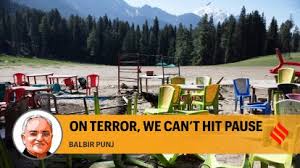01 May 2025 Indian Express Editorial
What to Read in Indian Express Editorial( Topic and Syllabus wise)
Editorial 1 : On Terror, we can’t Hit Pause
Context: Tackling ideology behind terror
Introduction: Terrorist attack in Pahalgam on April 22, 2025, lead to heightened tensions. PM Modi sent a strong message to the global community i.e. vowed to “identify, track, and punish” terrorists and their backers. Pakistan denied involvement in the attack, blaming homegrown factors and accusing India of exploiting minorities.
History of India-Pakistan Tensions
- Key Conflicts
- 1947-48: Pakistan’s invasion of Kashmir post-independence.
- 1965 and 1971 Wars: Full-scale military confrontations.
- 1999 Kargil War: Pakistan’s infiltration in Jammu and Kashmir.
- Post-1971 Shift in Pakistan’s Strategy
- Adoption of bleed India with a thousand cuts doctrine.
- Reliance on state-sponsored terrorism (e.g. 26/11 Mumbai attacks, 2016 Uri, 2019 Pulwama).
Pakistan’s Denial and Propaganda
- Consistent Denial of Terrorism: Pakistan rejects evidence linking its agencies to cross-border terror.
- Misleading Narratives: Linking Kashmir violence to India’s domestic politics
- Refusal to acknowledge ideological hostility toward India as a state policy.
India’s Counterterrorism Efforts and Internal Unity
- Post-2014 Progress
- Decimation of terror infrastructure, except J&K and Naxal regions.
- A decade of relative peace in most parts of India.
- Political Consensus: Unprecedented unity across parties against terrorism (contrast with 2016 Uri and 2019 Pulwama responses).
- Shift in Kashmir’s Public Sentiment
- Widespread protests in J&K against terrorism (e.g. Lal Chowk demonstrations).
- Decline in fear-driven support for separatist agendas.
Challenges and Lingering Threats
- Half-Done Battle
- Infrastructure vs. Ideology: While terror networks are weakened, the jihadist mindset persists.
- Rakt Beej Analogy: Radical ideologies regenerate unless ideologically countered.
- Complacency Risks
- Assumption of permanent normalcy in Kashmir is naive.
- According to David Mitchell, “Wars go into remission,” highlighting the cyclical nature of conflict.
Key Takeaways from the Developments
- Global Messaging: India’s assertive stance under Modi aims to isolate Pakistan internationally.
- Pakistan’s Inconsistency: Combative rhetoric on water treaties contrasts with denial of terror links.
- Kashmir’s Transformation: Public rejection of terrorism signals a socio-political shift.
- Long-Term Strategy Needed: Combating terrorism requires dismantling both infrastructure and extremist ideologies.
Conclusion: The Pahalgam attack underscores the fragility of India-Pakistan relations and the persistent threat of terrorism. India’s unified response and Kashmir’s evolving public sentiment are positive signs. Sustained efforts to counter radicalization and global diplomatic pressure on Pakistan are critical to breaking the cycle of violence.
Editorial 2 : Well Begun
Context: Mapping capex by private sector
Introduction: Ministry of Statistics and Programme Implementation (MoSPI) has released the first ever “Forward-Looking Survey on Private Sector CAPEX Investment Intentions”. Capex refers to capital expenditure, which means money spent towards the creation of long-term productive assets in the economy.
Key Findings
- Yearly CAPEX Volatility
- Rs 3.9 trillion in FY22
- Rs 5.7 trillion in FY23
- Rs 4.2 trillion in FY24
- Rs 6.6 trillion in FY25
- Rs 4.9 trillion in FY26 (projection)
- Growth Variability
- Between FY22 and FY25, the capex grew by 66%.
- Between FY22 and FY26, the overall growth fell to 23%.
- Private vs. Public CAPEX Growth
- Private Sector: Erratic growth, averaging around 23% over 5 years.
- Government CAPEX: 230% growth between FY21–FY25. It highlights the government’s aggressive infrastructure push compared to private sector hesitancy.
Challenges & Limitations
- Data Collection Issues
- Low Response Rate: Only 71% of surveyed enterprises shared full data.
- Reservations from Companies
- Concerns about legitimacy and cybersecurity risks.
- Reluctance to disclose sensitive financial information.
- Reliability of Findings
- MoSPI advises caution: Results are indicative, not definitive.
- Scope for Refinement: Future surveys will refine methodology and data accuracy.
Private Sector’s Role in Development
- CAPEX is critical for…
- Expanding production capacity.
- Boosting job creation and labour productivity.
- Transitioning India to a developed economy.
- Current Gap: Private CAPEX growth lags behind government efforts, signalling a need for policy interventions.
Way Forward: Recommendations
- Incentivize Private Investment: Tax breaks, easier credit access, and regulatory simplification.
- Improve Data Transparency: Address corporate concerns to enhance participation in future surveys.
- Long-Term Monitoring: Regular CAPEX tracking to identify trends and adjust policies.
Conclusion: The survey is a pioneering step to map private CAPEX, aiding policymakers and businesses. Despite volatility, private CAPEX remains pivotal for India’s economic ambitions. Sustained growth requires collaboration between the government and private sector. Subsequent surveys will enhance accuracy and provide deeper insights into investment patterns.
![]()


